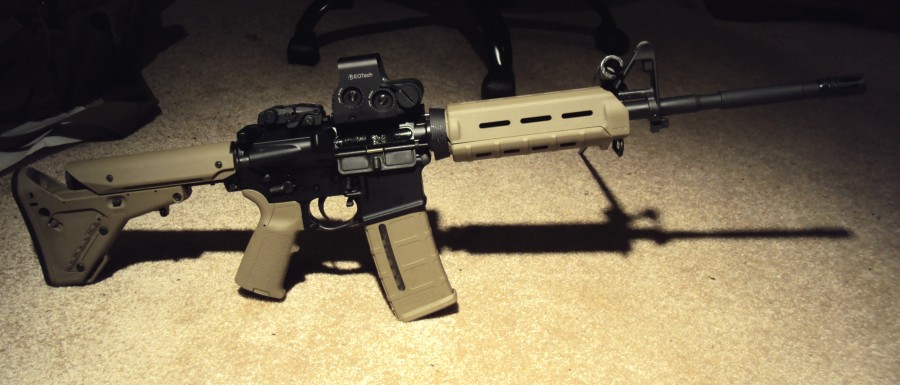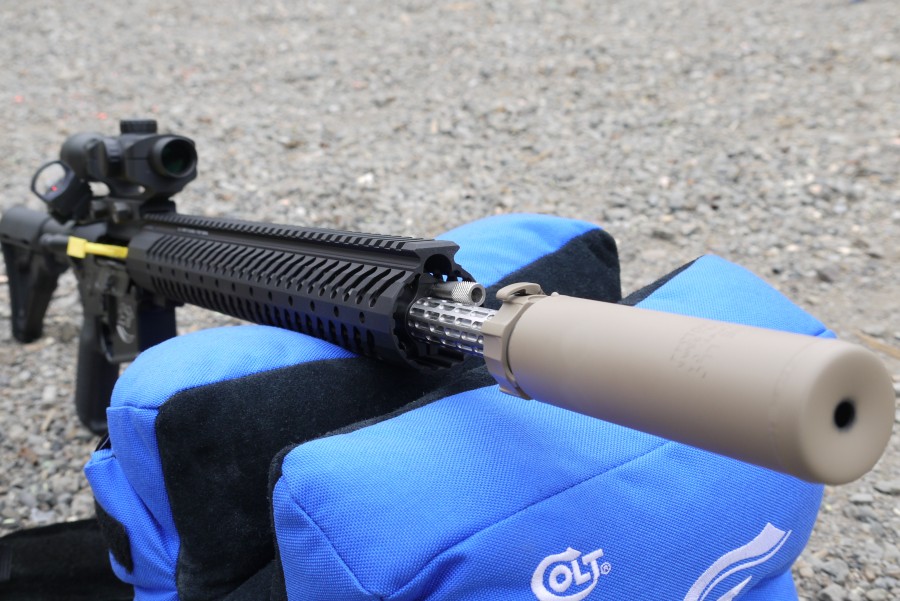Jim writes:
I have not been into guns since I left Viet Nam. When I came home I did not want to see guns much less shoot them. Now I am older and maybe wiser. I am trying to set up a DPMS Ar 15 and I would like the ability to use both iron sights and red dot. I have a SightMark red dot on the rifle now and want to include iron sights because I am so use to them from the service. What is the best and most secure way to attach both sights??
First, thank you for your service. Second, I think you’re talking about co-witnessing your sights.
There are a number of reasons for having both iron sights and an optic of some sort on your rifle. The first reason is keeping everything aligned. For someone like me who swaps their optics around their rifles like a teenager getting dressed for her first date, having a fixed reference point to quickly re-zero the optics is essential. Thanks to the iron sights that are always on the gun, I can co-witness the optics and get (more or less) the same zero every time.
The second reason is as a backup. Powered optics need batteries which eventually wear out. And because they’re electronic devices, they have a tendency to malfunction. So when the red dot kicks the bucket the iron sights are right there and already zeroed. And they’ll never run out of batteries.
With the AR-15 system, setting this up is pretty easy. The standard M4-profile upper receiver has a fixed front sight post, that triangle-looking thing on the front there. So thanks to that fixed front sight, you’ll only need a rear sight.
If you don’t have that fixed front sight then you’re going to need to get one of some sort, and that will differ depending on how your rifle is designed. Having a railed gas block will make things easier, as will having a full length top rail. You can just pop a front sight onto either of those and it will work just fine. Worst case scenario, you can always find a bolt-on or screw-on rail section and fix that to the rifle.
If you have an A4 style upper with the rail on top instead of the carry handle, then you’re already set to get the co-witness working. Pick an optic of your choice and a rear sight of your choice, and slap them on the rail (with the rear sight closer to your face) as seen above. If you have an A1 or A2 style upper then life will be a little more difficult, as you will need to figure out how to get the optic on the gun as there is no standard rail.
Once you’re done, follow these instructions to get everything lined up.
[Email your firearms-related questions to “Ask Foghorn” via [email protected]. Click here to browse previous posts]







I like the concept of using Dueck Defense Rapid Transition Sights for close with a scope for longer ranges.
So basically if I have a “standard” front site I can just get a red dot rear, and away I go!
I guess you could have an iron site on the back too, but I don’t think I would need it.
With my EOTech, I put just a folding front sight on, no rear. That way, if the battery goes dead I can just flip up the front sight, and center it in the middle of the EOTech window. It works just fine for 2 or 3 MOA.
I saw a red/green dot sight the other day for around $199 and it had a quick release as well. I forget the name of it darn it.
Get a good fold-down rear sight to go with those red-dots. If for some ungodly reason your red-dot comes off the weapon, at least you still have a full set of irons.
If you lose your BUIS, well then,
From the Hip!
Should add to this article offset sights. One of my AR’s now has a 4x with an offset fastfire2. The same could be applied to optic and offset iron sights. Personally I hate the obsession most have with cowitness. If I needed a iron sight option on top of my eotech on other AR, I’d offset the irons too, probably some flip ups on small DD 45 offsets.
Hello there, on the “co-witness” topic can you give me a few suggestions on a red dot or holographic optic that would work with or should i say allign with my magpul gen 2 sights, I know about the $600 and up set ups but some descent optics in the $100 to $250 range? My rifle is a flattop M4 with a Spector length rail and low pro gas block…… Thanks
@Trey – in most cases, you get what you pay for. Or put it this way, if there were “decent optics in the $100 to $250 range” that were as good as the $600 setups, then that’s what everyone would buy and the $600+ options simply wouldn’t exist. There’s a reason that they cost more.
I have an EOTech matched with a Primary Arms 3x (extended eye relief) magnifier and a flip-up mount. The whole setup cost $621 (shipping included). I’ve tinkered with the Burris fastfires and a number of other, less expensive, setups. None of them compared to the EOTech. Admittedly, “as good” and “good enough” are not the same thing. A fastfire may be “good enough”. But I can assure you that they aren’t as good as the more expensive setups.
Dont have rifle yet. Thinking of running vortex strikeforce with magpul pop ups. This work?
I have had a similar experience to that of “Jim” who’s missive leads this column. And, after approximately a year re-learning about rifle marksmanship I have my own take on the role of irons and red dot scopes which goes way beyond just using irons as BUIS. In fact, my use or irons and an rds could only be properly described as an integrated approach.
It starts with the realization that an RDS isn’t easily adjustable for windage or elevation, but, irons which are adjustable for both are imminently and easily adjustable. That along the companion realizations that RDS offers exceptionally quick target acquisition, whereas irons often require careful and relatively slower sight alignment for an excellent shot and that they restrict the shooters field of views more so than RDS suggests different roles for each sighting system. But there is overlap.
The author above mentions that irons can help him keep his optics approximately zeroed without having to fire a shot is one of the ways in which irons and RDS can compliment one another. But there are others.
I, like today’s Marines, zero my RDS and irons at 300 m. And, if I simply set them on 300 m and leave them that way then with the use of hold-overs / hold-unders with both then I can achieve a MPBR out to about 350m and not have to adjust fire on torso-sized targets within that range. But point targets within that range and all targets beyond that range out to 600 m the RDS without a BDC has limited effectiveness compared to a properly zeroed and sighted set of irons with an elevation and windage adjustable rear sight.
Additionally, with both sights zeroed at 300 m there is an objectionably large difference between LOS and bullet trajectory within 200 m when using either sighting system (as much as 9″, depending on load and rifle). At this point, it’s useful to switch to irons and adjust the rear sight’s elevation to 200 m which allows the shooter to enjoy a much lessened disparity between LOS and the ballistic profile of the round using an RDS (often a mere 2″ or less).
Additional uses of the sighting systems together are 1) the suppression of the effects of an astigmatism on the “blooming” of the red dot by viewing the dot through the rear sight orifice and 2) the use of the dot (again, zeroed at 300 m) to “highlight” the top of the FSP when the elevation is adjusted to 200m and if the light conditions make seeing the FSP difficult (my rifle’s dot falls just below the tip of the iron FSP when the irons are dialed to 200 m making it appear as if I’d painted the FSP with glowing, luminescent red paint) So, finding and, with old eyes, keeping focus on the FSP for use on point targets in bad light when firing at less than 200 m is greatly simplified.
Finally, only windage adjustable irons can deliver an acceptable shooting solution in high winds without using Kentucky windage which would be required with RDS.
So, I recommend that shooters consider the possible dual, complimentary and even perhaps simultaneous use of both an RDS and elevation and windage adjustable irons when the shooting solution and light conditions make that an advantage.
LF
Comments are closed.